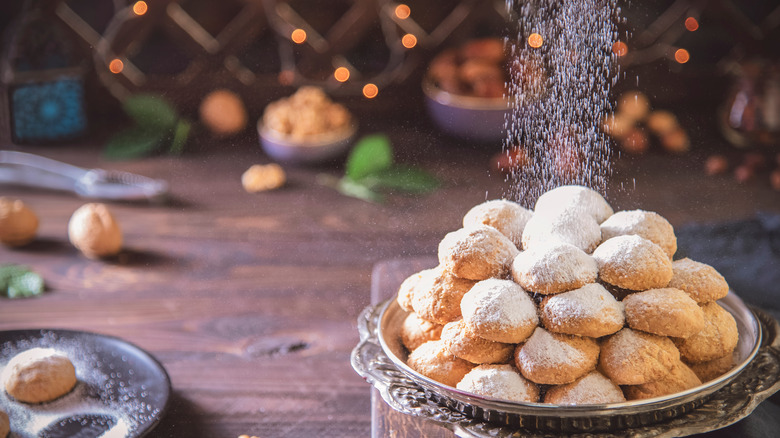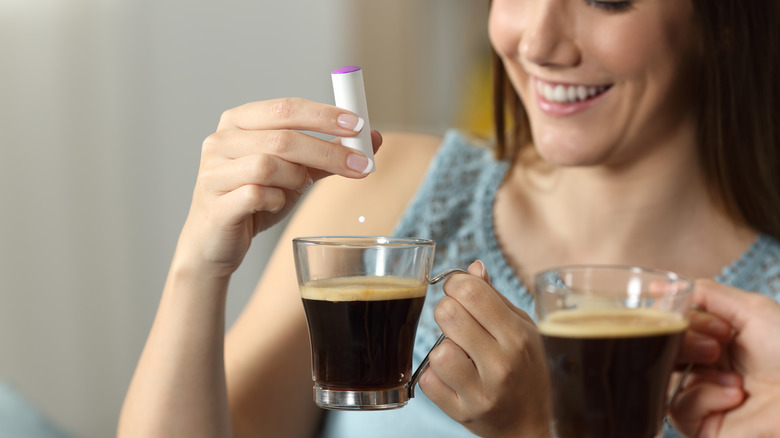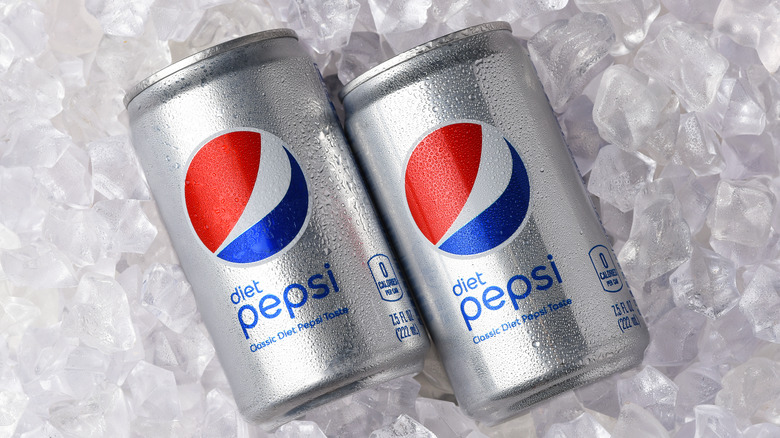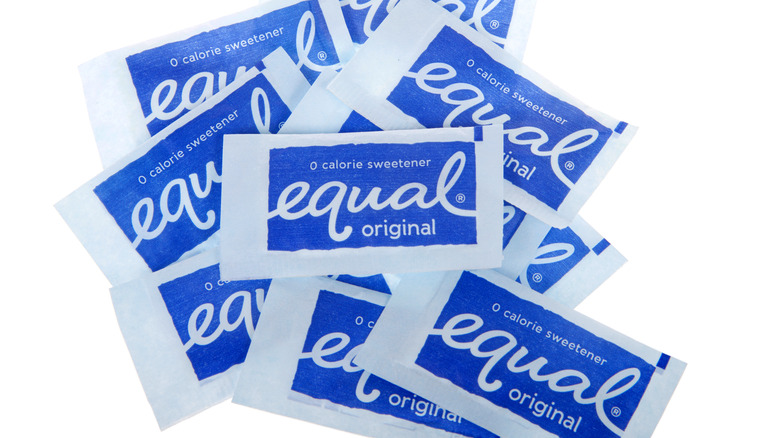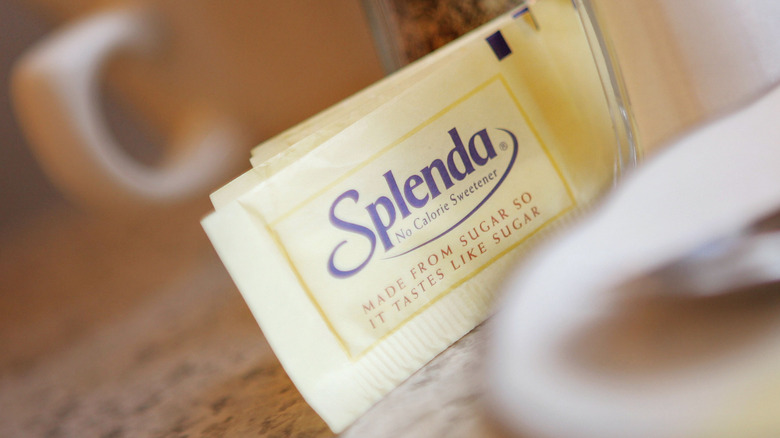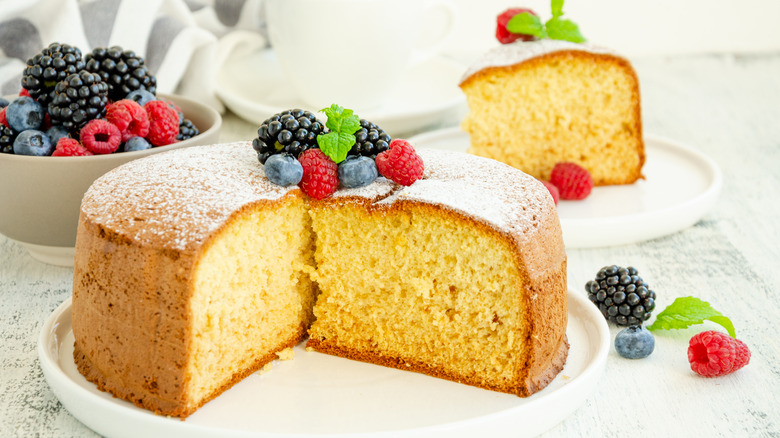These Artificial Sweeteners Were Made By Accident
Throughout history, there have been plenty of accidental inventions, from microwaves to X-rays to the Slinky (via InventionLand). You might not know that sweeteners you eat all the time often had unexpected creations, too — and sometimes, they're very different from their originally intended uses as insecticides or fever medicines.
Why make a sugar substitute in the first place? Though we now know that sugar substitutes can increase your chances of gaining weight (via Smithsonian), excessive amounts of standard sugar can cause weight gain and health issues such as Type 2 diabetes, cancer, and heart problems. Indeed, doctors have long suggested that people should cut back on the amounts of sugar and fat in their diets. But since that isn't much fun, researchers are always looking for the next best delicious, harmless, and calorie-free substance. This has historically led people to try and find healthier sugar alternatives, starting all the way back in 1879.
World's first artificial sweetener
According to the American Chemical Society, people were thinking about alternatives to sugar over 200 years ago. In 1879, a college student at John's Hopkins University accidentally discovered a new substance. The student, Constantin Fahlberg, was working with a coal tar derivative called benzoic sulfimide. He got some on his hand and realized it was a super sweet substance. As Saveur reports, Fahlberg tasted everything in his lab until he figured out which chemical it was and gave it the name "saccharin." Fahlberg and the head of the lab, Ira Remsen, tweaked the compound until it was market-ready, and Fahlberg eventually began to sell saccharin in Germany around the 1880s.
But in 1906, a movement was started to ban artificial sweeteners, led by the head chemist of the U.S. Department of Agriculture. This was an unpopular move, and it didn't work. The president at the time, Theodore Roosevelt, who actually took a dose of saccharin as prescribed by his doctor, was quoted as saying (via the American Chemical Society), "Anyone who says saccharin is injurious to health is an idiot."
And by 1907, saccharin was being used in lots of American foodstuffs, although this wasn't widely known among consumers. That didn't stop experts from trying to ban it, and they nearly succeeded. But then World War I began, and tight sugar rations made saccharin a very popular substitute.
Cyclamate — 50 times sweeter than sugar
In 1937, the next big breakthrough in artificial sugar also happened completely by accident. At the University of Illinois, a graduate student named Michael Sveda was trying to create a drug to lower fevers. He took a smoke break and realized that his hand smelled and tasted sweet. The chemical, cyclamate, is roughly 30 to 50 times sweeter than ordinary sugar (via Saveur).
While originally intended for use in diabetics, it became a staple in tons of foods, including chocolate, candy, jelly, cereal, toothpaste, and salad dressing (via Cyclamate Information Center). Cyclamate's rollout had great timing, too, because diet soda was becoming a fad in the 1950s. It rapidly became America's top-selling artificial sweetener and was used in popular drinks like Diet Pepsi and Tab. It was also the main ingredient in Sweet'N Low.
According to the Sweet'N Low website, Ben Eisenstadt and his wife dined at a restaurant, and his wife commented on how unsanitary the fly-swarmed sugar bowl on the table must be. Inspired by her idea, Eisenstadt used a tea-bag machine to create single-serve packets of Sweet'N Low. They trademarked the idea in 1957, and by 1963, the product hit grocery stores throughout the U.S.
But the hype didn't last. Scientists realized that in high doses, the chemical gave lab rats bladder cancer. Cyclamate was banned by the FDA in 1970, and manufacturers had to quickly pivot to other artificial sweeteners after the ban, which remains in place to this day.
All about aspartame
The next sweet chemical to be accidentally discovered was actually supposed to be an ulcer medication. But as the legend goes, James Schlatter, a researcher at G.D. Searle and Company, accidentally licked his fingers while testing the chemical in 1965. He discovered that aspartame is 200 times sweeter than regular sugar, and the rest is history (via Saveur). According to Food Insight, aspartame isn't good for cooked or baked foods. But it's used in many other products, like vitamins, condiments, ice cream, syrup, and yogurt. You might know it as the main ingredient in Equal, a U.S.-based artificial sweetener that comes in a single-serve packet.
After a hiccup with the FDA following claims that aspartame can cause brain tumors, the product went to market in 1981. There are anecdotal complaints of health concerns linked to the chemical — perhaps because more than a billion pounds of sugar in American products were replaced by aspartame in the 1980s-1990s (via Saveur). However, while previous sweeteners like cyclamate were found to be hazardous, aspartame has been through more than 200 safety studies and has been determined to be safe for kids and adults (via Food Insight). One of the most popular products to use aspartame is Diet Coke, and it's still used in the drink today.
Insanely sweet sucralose
As Science Direct reports, sucralose was first discovered in 1976 when a sugar company based in Britain was testing chemicals in order to transform sucrose into a sugar substitute or additive. They created a sweetener that was 450 to 650 times sweeter than sugar while containing zero calories, and they never would have discovered this if it weren't for a small miscommunication between scientists. One researcher, Shashikant Phadnis, was told to "test" sucralose, a chemical that was supposed to be a new insecticide. But instead, Phadnis thought his coworker said to "taste" it (via Wise Geek). He ate some, and luckily, the substance was very sweet and not hazardous.
It was approved by the FDA in 1998 for use as a "tabletop sweetener" and got approval to be used in desserts and nonalcoholic drinks. Sucralose became the main ingredient in Splenda and is a popular additive to gum, breakfast cereals, and sodas. As Saveur reports, sucralose differs from early sweeteners because you can cook and bake with it. Interestingly, the substance is so sweet that researchers even found that when pregnant people ingested sucralose, their breast milk became sweeter.
The sweetest replacement ever discovered
One of the newest players in the artificial sweetener game is advantame, and it is insanely sweet — a staggering 20,000 times sweeter than sugar. A biotech and food company based in Japan discovered the chemical in 2008, and it can be made for just one-hundredth the price of sugar (via Bayn Solutions). There are quite a few benefits discovered so far: there are no known health impacts to lab animals or humans, it can be heated up, and it is reportedly safer than aspartame. Since it became FDA-approved in 2014, advantame has been used as a "high-intensity sweetener" in baked goods (via the FDA). The only thing it can't be used in is meat products.
As one of the strongest sugar alternatives on the market, researchers are always striving to find the next best sugar replacement. With a little creative testing — and tasting — only time will tell what the future of sweeteners has in store.
